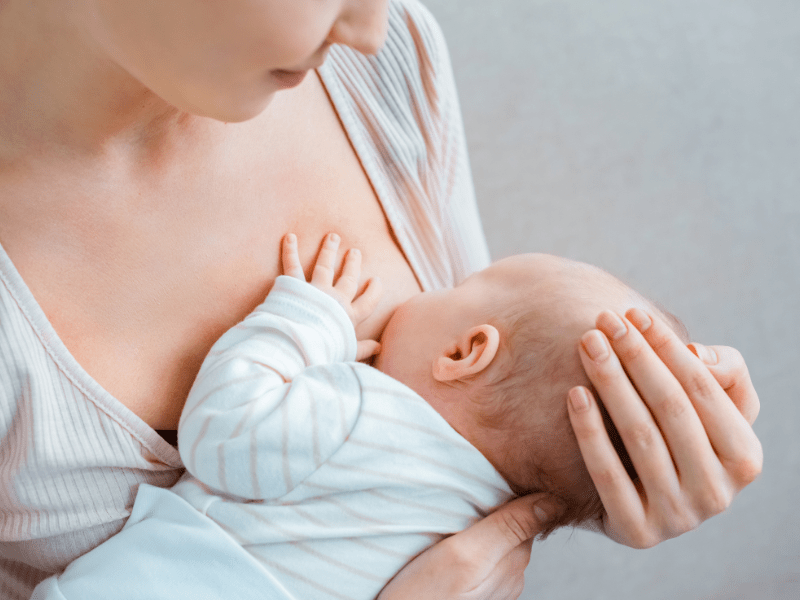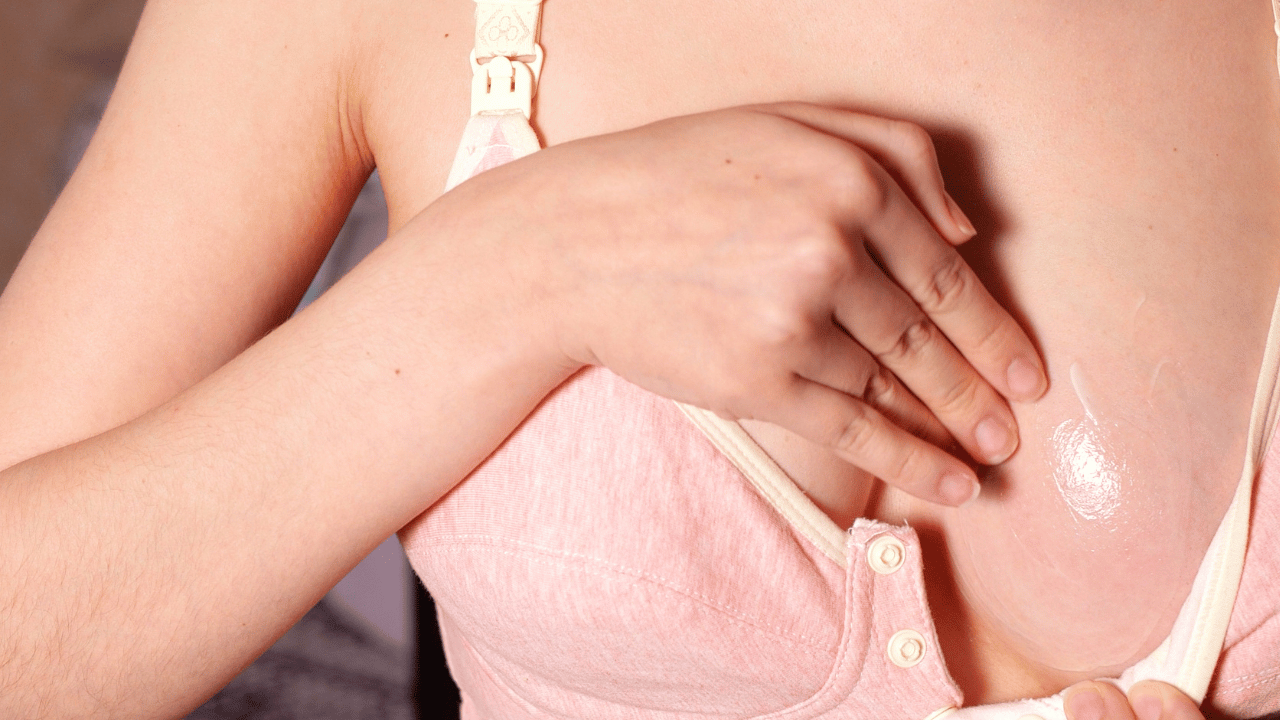Finding a lump in breast tissue can feel scary, but not all lumps are serious. This article will walk you through the different types of breast lumps, what signs to look out for, and when to check in with your doctor. Knowing what’s normal and what’s not can give you peace of mind.
Finding Lumps in Your Breasts
Lactating breasts often feel lumpier than usual. That’s normal. They hold more milk, more blood, and more lymph. The amount of milk changes from day to day, which can make your breasts feel different, too.
In the first few weeks after birth, your breasts may feel very full and firm. This is called engorgement, and it can cause lumps. Later on, you might feel a small, sore lump in breast tissue. That’s often a blocked milk duct, which is common and usually easy to treat at home.
But if a lump in breast tissue lasts more than a week—even after you’ve tried clearing the duct naturally—it’s time to call your doctor. They may suggest tests like an ultrasound, mammogram, biopsy, or blood work. You can still breastfeed during most of these. If a lump or cyst needs to be removed with surgery, your milk supply may drop a little.
It’s rare, but sometimes a lump in breast tissue while breastfeeding can be cancer. Catching it early makes a big difference. If you need radiation or chemotherapy, you’ll need to stop breastfeeding.
What to Do If You Find a Breast Lump
- Keep breastfeeding your baby, even if you feel a lump in breast tissue. Nursing often helps clear blocked milk ducts.
- Try gently massaging the lump toward your nipple. This can help loosen any blockage and get the milk moving again.
- Check your baby’s latch. If it’s too shallow, it might cause more clogged ducts.
- Let your baby nurse from the side with the lump in breast first. Babies suck harder at the beginning of a feed, which can help clear the clog.
- Try different nursing positions. A new angle might help empty other parts of the breast. Dangle feeding can be helpful for tough plugs or milk blisters.
- After feeding, hand express or pump to fully drain the breast. This helps prevent clogs from coming back.
- Use breast compressions while feeding to keep milk flowing. This can also help move the blockage through.
- If you see a small white spot or blister on your nipple, it could be a bleb. Once it opens, the milk can usually flow freely again.
- Apply a warm compress or take a warm shower before feeding. It helps soften the tissue and improve flow.
- Use a cold compress after feeding to reduce pain and swelling. It can make things feel a lot better.

Signs That May Indicate Problems Other Than Plugged Ducts/Mastitis
- If your baby keeps refusing to nurse on one side, it could be because of a lump in the breast tissue. The area might taste different due to inflammation or slower milk flow, making your baby fussy at the breast.
- If milk production drops on the side with the lump, even though your baby is feeding well, it may be a sign of a deeper problem. A plugged duct or swelling can block milk flow and cause supply to decrease.
- If you feel pain, swelling, or warmth in the breast but don’t have a fever, it might still be mastitis. Sometimes mastitis doesn’t come with a fever and doesn’t always respond to antibiotics.
- A plugged duct that keeps coming back in the same spot could mean there’s a chronic blockage. If this happens often, and especially if it’s always the same area, get it checked. It might be more than just a simple lump in breast tissue.
While breastfeeding, it’s still important to check your breasts regularly. Feel for any firm or hard spots that don’t go away after nursing or pumping. Stand in front of a mirror and look for changes in shape, size, or skin texture. Talk to your doctor about any lump in breast that feels unusual or sticks around.
Breast Lumps in the Armpit
Breast tissue goes all the way up into your armpits, so it’s normal to feel lumps there. This area is called the “tail of Spence.” A lump in breast or armpit tissue is common in the first few weeks after birth, especially when your milk first comes in and your breasts are very full.
Some people also have milk-making tissue outside the main breast area—like under the arms or even near the chest wall. This tissue can swell up and feel sore when your milk comes in, but it usually settles down once the early engorgement eases.
Sometimes, a lump under the arm can show up later during breastfeeding, especially if your breasts haven’t been emptied well. It’s not common, but it can happen. The extra milk may back up into nearby tissue, even under the armpit, and create pressure similar to a lump in breast tissue.
If you feel swelling or pain in the armpit, try to relieve it quickly. Untreated engorgement—whether in the breast or under the arm—can lead to mastitis. It’s best to get things flowing again within two days to avoid infection.
More Recent Research 2023 – ‘these adjacent but separate axillary mounds are not a tissue extension of the primary breast. Instead, there is a growing awareness that separate focal vestigial breast mounds are consistently present in adults, located in pairs running down the curved lines of the embryological mammary ridges’ – Tail of Spence
10 Possible Causes of Lumps While Breastfeeding
& Symptoms
#1 Engorgement
In the early days after birth, your breasts may feel hard, shiny, and sore. This is called engorgement. It happens when your milk first comes in or if your baby isn’t feeding enough.
Signs include:
- Skin looks tight and shiny
- Breasts feel hard and sore
- Nipples seem flat, making latching harder
- Lumps under the armpits
A lump in breast tissue during engorgement is common. Feed your baby often and avoid skipping sessions to help things settle.
#2 Plugged Ducts
This is the most common type of lump. Plugged ducts are usually small, sore, and go away within a few days with regular nursing.
Causes include:
- Skipped feeds
- Shallow latch
- Tight clothing or bras
- Incomplete breast drainage
Symptoms:
- A lump in breast that feels like a pea or larger
- Nipple bleb (white spot or blister on the nipple)
- Breast tenderness
- Baby fussing at that breast due to slower flow
#3 Mastitis
Mastitis is an infection that can make a lump feel hot and very painful. You may get a fever or flu-like symptoms. Get to the doctor as soon as possible.
Other signs include:
- Burning or stabbing feeling inside the breast
- Redness and swelling
- A painful lump in breast area
Untreated mastitis can turn into an abscess, which needs medical care right away.
#4 Cysts
Cysts are fluid-filled lumps in breast tissue. They’re usually soft and move easily under the skin. Some contain milk and are called galactoceles. These are not harmful and don’t affect breastfeeding.
If a lump doesn’t go away or gets bigger, your doctor might want to drain it or remove it. Most cysts are harmless, but it’s still best to have them checked.
#5 Fibrocystic Changes
Some breasts are naturally lumpier than others. These changes are not dangerous. You may notice the area feels bumpy or thick, and it may be more tender around your period.
A fibrocystic lump in breast tissue usually comes and goes. Vitamin E or Iodine may help in some cases, but always talk to your doctor before starting supplements.
#6 Lipomas
Lipomas are soft, fatty lumps that grow slowly over time. They aren’t painful and don’t usually cause problems. A lipoma is a type of lump in breast that’s benign and doesn’t affect milk supply.
#7 Hematomas
A hematoma forms after an injury or surgery. It’s a pocket of blood under the skin and can feel like a painful lump. The area may look bruised or swollen.
If you feel a lump in breast tissue after a fall or bump, and it’s sore or changes color, see your doctor to rule out anything serious.
#8 Diabetic Mastopathy
This rare condition shows up in people with long-term diabetes. The lumps are usually firm, painless, and can feel irregular in shape. These do not affect your ability to breastfeed.
A lump in breast tissue caused by diabetic mastopathy won’t go away on its own, so it’s worth getting it checked to confirm what it is.
#9 Abscess
An abscess is a pocket of pus that forms when an infection like mastitis is not treated in time. It feels like a painful, swollen lump in breast tissue. The skin may be red, warm, or shiny over the area.
Abscesses often require drainage by a doctor. You can usually keep breastfeeding, but you may need to avoid nursing directly on the affected breast for a short time, depending on treatment.
#10 Breast Cancer
While rare during breastfeeding, breast cancer can still happen. Cancerous lumps are often firm, don’t move easily, and are usually not painful. Some types may feel like mastitis but don’t go away.
Watch for these signs:
- A lump in breast that doesn’t shrink
- Dimpling or rough skin (like an orange peel)
- Swelling that doesn’t go down
- Changes in nipple shape or discharge
If you have symptoms of mastitis lasting longer than three days, or something just feels off, don’t wait—get it checked.
Prevention While Breastfeeding
To help prevent issues like a lump in breast tissue, it’s important to take care of your breasts while nursing. Here are some easy tips:
- Breastfeed on demand. Let your baby feed whenever they want—even for comfort. This helps keep milk moving and prevents build-up that can lead to plugged ducts.
- Wear comfortable bras. Make sure your bras fit well and don’t use underwires. A bra that’s too tight can put pressure on your breasts and lead to blocked ducts.
- Wean slowly. If you need to stop breastfeeding, drop one or two feeds per week. Weaning too fast can cause engorgement and increase the risk of mastitis.
- Watch your diet. Some experts suggest cutting back on caffeine and high-fat foods. These may make fibrocystic changes more noticeable in some people.
- Massage your breasts. Gentle breast massage can help improve milk flow, relieve fullness, and keep things moving. It’s a good habit to have, especially if you’re prone to clogged ducts.
Diagnostic Procedures and Breastfeeding Safety
If you need tests or procedures for a lump in breast tissue, don’t worry—most of them are safe while breastfeeding. Here’s what you should know:
- X-rays are safe. They do not affect your breast milk or your ability to nurse. NCBI
- Ultrasounds and CT scans are also safe. You can keep breastfeeding without stopping.
- Mammograms can be done while breastfeeding, but results may be harder to read due to dense milk-filled tissue. There’s limited research on safety, but many doctors say it’s fine with no need to pump and dump.
- MRIs are considered safe. Recent studies show that the contrast dye used does not pass into breast milk in harmful amounts.
- Fine needle aspiration removes fluid from a lump in breast using a small needle. You can breastfeed right afterward.
- Core biopsies use a larger needle under local anesthetic to take a sample. These are safe, and you can breastfeed after the procedure.
- Surgical biopsy involves a small cut to remove a lump. If the cut isn’t near your nipple or the area your baby latches onto, breastfeeding can continue without stopping.
- Fine needle biopsy is another safe option. It only removes a few cells for testing, and there’s no need to pause breastfeeding.
Always tell your doctor and surgeon that you’re breastfeeding. Finding a provider who supports breastfeeding can make a big difference.
Keep in mind—abrupt weaning is not recommended. It can lead to more pain, swelling, or infection. Breast milk also helps heal the breast from the inside out. So continuing to breastfeed can actually help you recover faster.
Further Treatments
If you’re being treated for a lump in breast tissue and need more advanced care, here’s what to expect with common treatments:
- Chemotherapy is not safe for breastfeeding. The medications can pass into breast milk, so you’ll need to stop nursing during treatment. Infant Risk Center – Medication, chemotherapy, radiation, and diagnostics during breastfeeding.
- Radioactive treatments may require you to pump and dump your milk for a while. Your doctor will let you know when the radiation has cleared from your system and it’s safe to breastfeed again.
- Radiation therapy is usually given to only one breast. You can keep breastfeeding from the untreated side. The treated breast may make less milk afterward, but many mothers continue to breastfeed successfully.
When You Need to Go to the Doctor
It’s always okay to trust your instincts. If something doesn’t feel right, get it checked. See your doctor if you notice any of the following:
- Puckering or dimpling of the skin around a lump in breast tissue
- A rash or redness on your breast or nipple
- Ongoing discharge from the nipple
- Pain in your breast or armpit that doesn’t go away
- Swelling near your collarbone or in your armpit
- Nipple pulling inward (called nipple retraction)
- A lump that’s been there for more than a week without change
Early care makes a big difference. You don’t need to stop breastfeeding to get checked out.
Q&A
Not all lumps are painful. Some are harmless and go away on their own. Still, any lump in breast tissue should be watched closely—especially if it sticks around for more than a week. It’s always okay to ask your doctor to check it out, even if there’s no pain.
Yes. A hard lump in breast tissue during breastfeeding could be something simple, like a blocked duct. But if it doesn’t get smaller after nursing, or if it lasts more than a week, you should have it looked at. Early care is always best.
References and Resources
- La Leche League International Online Breastfeeding Support Groups
- American College of Radiology (ACR) – Breast Imaging During Lactation


